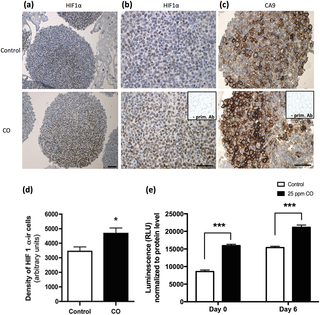PLOS ONE ( IF 2.9 ) Pub Date : 2018-01-16 , DOI: 10.1371/journal.pone.0191207 Nanna Dreyer-Andersen 1 , Ana Sofia Almeida 2, 3, 4 , Pia Jensen 1 , Morad Kamand 1 , Justyna Okarmus 1 , Tine Rosenberg 5 , Stig Düring Friis 6 , Alberto Martínez Serrano 7 , Morten Blaabjerg 8 , Bjarne Winther Kristensen 5 , Troels Skrydstrup 6 , Jan Bert Gramsbergen 1 , Helena L A Vieira 2, 4 , Morten Meyer 1, 8

|
Exploratory studies using human fetal tissue have suggested that intrastriatal transplantation of dopaminergic neurons may become a future treatment for patients with Parkinson’s disease. However, the use of human fetal tissue is compromised by ethical, regulatory and practical concerns. Human stem cells constitute an alternative source of cells for transplantation in Parkinson’s disease, but efficient protocols for controlled dopaminergic differentiation need to be developed. Short-term, low-level carbon monoxide (CO) exposure has been shown to affect signaling in several tissues, resulting in both protection and generation of reactive oxygen species. The present study investigated the effect of CO produced by a novel CO-releasing molecule on dopaminergic differentiation of human neural stem cells. Short-term exposure to 25 ppm CO at days 0 and 4 significantly increased the relative content of β-tubulin III-immunoreactive immature neurons and tyrosine hydroxylase expressing catecholaminergic neurons, as assessed 6 days after differentiation. Also the number of microtubule associated protein 2-positive mature neurons had increased significantly. Moreover, the content of apoptotic cells (Caspase3) was reduced, whereas the expression of a cell proliferation marker (Ki67) was left unchanged. Increased expression of hypoxia inducible factor-1α and production of reactive oxygen species (ROS) in cultures exposed to CO may suggest a mechanism involving mitochondrial alterations and generation of ROS. In conclusion, the present procedure using controlled, short-term CO exposure allows efficient dopaminergic differentiation of human neural stem cells at low cost and may as such be useful for derivation of cells for experimental studies and future development of donor cells for transplantation in Parkinson’s disease.
中文翻译:

间歇性低剂量一氧化碳暴露可增强人类神经干细胞的存活率和多巴胺能分化
使用人类胎儿组织的探索性研究表明,多巴胺能神经元的纹状体内移植可能成为帕金森病患者的未来治疗方法。然而,人类胎儿组织的使用受到伦理、监管和实际问题的影响。人类干细胞构成了帕金森病移植的替代细胞来源,但需要开发控制多巴胺能分化的有效方案。短期、低水平的一氧化碳 (CO) 暴露已被证明会影响多种组织中的信号传导,从而导致保护和活性氧的产生。本研究调查了一种新型CO释放分子产生的CO对人类神经干细胞多巴胺能分化的影响。分化后 6 天进行评估,第 0 天和第 4 天短期暴露于 25 ppm CO 显着增加了 β-微管蛋白 III 免疫反应性未成熟神经元和表达儿茶酚胺能神经元酪氨酸羟化酶的相对含量。微管相关蛋白2阳性成熟神经元的数量也显着增加。此外,凋亡细胞(Caspase3)的含量减少,而细胞增殖标志物(Ki67)的表达保持不变。暴露于 CO 的培养物中缺氧诱导因子 1α 的表达增加和活性氧 (ROS) 的产生增加可能表明涉及线粒体改变和 ROS 产生的机制。总之,目前使用受控的短期CO暴露的程序可以以低成本实现人类神经干细胞的有效多巴胺能分化,因此可能有助于衍生用于实验研究的细胞和未来开发用于帕金森病移植的供体细胞。











































 京公网安备 11010802027423号
京公网安备 11010802027423号